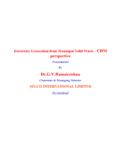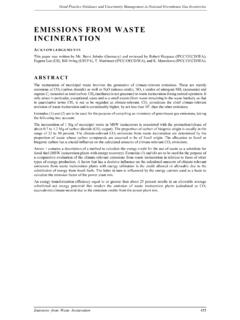Transcription of Determination of the fossil carbon content in combustible ...
1 Determination of the fossil carbon content in combustible municipal solid waste in Sweden RAPPORT U2012:05. ISSN 1103-4092. Preface The predictions of waste incinerations contribution to climate change is based on sorting analysis and assumptions that provides a simplified picture with major sources of error. A study with C14 method has shown that the proportion of fossil carbon dioxide from waste incineration, probably is less than believed. The aim of this project was to determine the proportion of the fossil emissions from waste incineration in Sweden by measurements of waste and flue gas. The project was conducted by Evalena W Blomqvist and Frida Jones, both from SP Technical Research Institute of Sweden.
2 Malm , Sweden April 2012. H kan Rylander Weine Wiqvist Chairman of the Research and Development Managing Director Committee, Swedish waste Management Swedish waste Management Abstract Determination of the fossil carbon content in combustible Swedish municipal solid waste This project aimed to determine the fossil carbon content in municipal solid waste used as a fuel in Sweden by using four different methods at seven geographically spread combustion plants. In total, the measurement campaign comprised 42 solid waste samples, 21 flue gas samples, three sorting analyses and two investigations of fossil carbon content by using the balance method. The fossil carbon content in the solid waste samples and in the flue gas samples was determined by using an accredited laboratory for C14 analysis.
3 From the C14 analyses it was concluded that about a third of the carbon in solid waste is of fossil origin. The two other methods, based on assumptions and calculations, gave similar results in the plants where they were used. Furthermore, the chemical characterisation of all the solid waste samples showed a relatively homogeneous composition in terms of the elements present. A systematic error for the solid sampling method was discovered during the project, making the total measurement uncertainty 14 % fossil carbon , compared to 3 % fossil carbon for the flue gas samples. It was also noted that the accuracy of determining the fossil content by sorting analysis is greatly affected by knowledge of, and correct data for, different waste fractions, and particularly for the plastic fraction's moisture content .
4 Key words: waste combustion, fossil share, C14. Abbreviations AMS Accelerator Mass Spectrometry pMC Percentage Modern carbon SD Standard Deviation SRF solid Recovered Fuel Preface This project has been a substantial national project that has provided a wealth of interest and learning. All those involved in it have participated with great enthusiasm and generosity of expertise and knowledge. We would like to take this opportunity to thank everyone involved from the following organisations: Swedish waste Management, the Swedish Energy Agency, the Swedish Environmental Protection Agency, SP, Profu, Ramb ll, Milj m tarna and those who participated from the seven waste combustion plants: D va CHP plant (Ume Energi), H gdalen (Fortum), H ndel verket (Eon), Tekniska Verken in Link ping, Ryaverket (Bor s Energi och Milj ), Renova (G teborg) and Sysav in Malm.
5 Summary The results from this project show that the proportion of fossil carbon in municipal solid waste used for combustion in Sweden is about one third. The conclusions are based on results from four different analysis methods used in seven waste combustion plants in Sweden. Each plant took six solid waste samples and three flue gas samples, and both types were analysed in terms of the proportion of fossil carbon at Betalab Inc. in Miami, USA. In addition, all solid waste samples were also used for further chemical characterisation, which gave a good picture of the waste 's chemical composition and its variations. In addition to the solid samples and flue gas samples, three of the plants performed sorting analyses, and two plants used the balance method to calculate the fossil content by using the software BIOMA.
6 The balance method is a method based on the fact that there are several fundamental differences between how the biogenic carbon and the fossil carbon react in a combustion process. These differences allow separation of the processes by computer models. The results from the chemical characterisation of the waste show that the difference between the samples that contained high proportions of industrial waste (nearly 80 %) and the municipal solid waste were not as great as first expected. The main parameters, such as the amounts of carbon , oxygen and hydrogen, show a relative standard deviation of less than 10 %. The mean calorific value of all samples was measured to be about 11 MJ/kg.
7 The results from the fossil proportion study of all solid samples and flue gas samples indicate fossil carbon proportions of 36 % and 38 % respectively. This corresponds to a fossil carbon share of approximately 10 % by weight in a waste mixture. The two other methods, based on assumptions and calculations, gave similar results in the plants where they were used. Simplified, it can be said that a third of the waste that is combusted in Sweden has a fossil origin. During the project, a systematic error was discovered in the solid waste sampling method. The method delivers too low results when there is a low proportion of fossil carbon in the waste , and slightly too high results when there is a higher proportion of fossil material in the waste .
8 The total measurement uncertainty ( the sum of the random and systematic errors) is estimated to amount to 3 % fossil carbon for the flue gas samples, while the solid sampling method has a much greater uncertainty due to the systematic error, amopunting to 14 % of fossil carbon . The accuracy of determining the fossil proportion by sorting analysis is greatly affected by knowledge of and correct facts about different waste fractions, mainly the moisture content of the plastic fraction. The balance method was evaluated over a three-month period by installing the software in one plant, and using previously logged data from another plant to perform calculations.
9 Overall, the balance method is a user-friendly method, but there are some areas that need to be further developed before it is fully suitable for this application. The method was used for only a short period of time in this project, which means that there are significant potential to improve the measurement uncertainty for continuous use. Besides investigating the fossil proportion of the waste , the project also included investigation of the usability of various methods. However, it is difficult directly to compare the different methods used in this project as, in addition to estimation of fossil carbon emissions, the methods provide other information, of value to the plant owner.
10 The choice of method can also be affected by factors other than direct Determination of the fossil fuel emissions. Contents 1 Background 1. Project aims 1. The project group 2. Legal requirements and regulations 2. Earlier studies in Sweden 3. 2 Methods 4. Sampling plan 4. Sampling of solid waste fuels 5. Grate-type boilers 5. Fluidised bed boilers 5. Fuel analyses 5. Element analysis 5. Determination of the proportion of fossil carbon in solid waste samples 6. Flue gas sampling 6. Determination of the proportion of fossil carbon 6. Background concentration 6. Calculation of fossil carbon 7. fossil -free waste a reference 7. The balance method 8. The sorting analysis method 9.







